
Original Link: https://www.anandtech.com/show/2276
Intel Core 2 Extreme QX6850 and Massive Price Cuts
by Anand Lal Shimpi on July 16, 2007 3:04 AM EST- Posted in
- CPUs
We finally have it! After well over a year of asking nicely, rudely and creatively - we know when AMD's next generation microarchitecture is being launched.
Well, sort of.
Barcelona, as you maybe remember, is the code name for AMD's next-generation server processors. AMD recently announced that in August, it will unleash Barcelona unto the world at clock speeds of "up to 2.0GHz." But Barcelona only applies to the server world, and today we're reviewing a desktop microprocessor, so when do we get to see AMD's brand new Phenom processors on the desktop?
We'd expect Phenom in our hands 30 days after Barcelona's launch, making it approximately September/October by the time you'd see a preview/review and widespread availability about 30 days from that. If all goes perfectly, AMD's Phenom chips should be in customers' hands by November or December at the latest.
Penryn, Intel's 45nm update to its current Core 2 processors, will also make its debut at the end of this year, potentially spoiling AMD's launch party. A few possibilities exist with Penryn:
1) Penryn could launch across the board at all clock speeds and at competitive prices, quite possibly the worst case scenario for AMD, or
2) Penryn could launch strictly at upper clock speeds/price points, allowing AMD to have an easier time competing at lower speeds, or finally
3) Penryn could launch at lower clock speeds and price points, giving AMD an equally hard time as in the first scenario
It's important to recap AMD's impending launch as we've had yet another round of price cuts, making buying a new CPU today very attractive.

Today is supposed to mark the introduction of the first 1333MHz FSB quad-core Core 2 Extreme processor, the QX6850 (mouthful anyone?), as well as the official launch of the entire 1333MHz FSB lineup. But this is the second Core 2 Extreme launch that coincides with a ridiculous (in a good way) price drop, so we can't help but shift our focus for this story, at least for starters...
| CPU | Clock Speed | FSB | L2 Cache | Pricing |
| Intel Core 2 Extreme QX6850 | 3.00GHz | 1333 | 4MBx2 | $999 |
| Intel Core 2 Duo E6850 | 3.00GHz | 1333 | 4MB | $266 |
| Intel Core 2 Duo E6750 | 2.66GHz | 1333 | 4MB | $183 |
| Intel Core 2 Duo E6550 | 2.33GHz | 1333 | 4MB | $163 |
Once More, With Feeling
We've already been through one major set of Intel price cuts this year, that was just three months ago after the Core 2 QX6800 launch. The smoke hadn't even cleared from the first round but both AMD and Intel are back in price slashing mode.
AMD already cut its prices before today's article, while Intel's cuts aren't scheduled to take effect until July 22nd (next week). We'll start off with AMD's pricing:
| CPU | Clock Speed | L2 Cache | Price |
| AMD Athlon 64 FX-74 | 3.0GHz | 1MBx2 | $599/pair |
| AMD Athlon 64 X2 6000+ | 3.0GHz | 1MBx2 | $178 |
| AMD Athlon 64 X2 5600+ | 2.8GHz | 1MBx2 | $157 |
| AMD Athlon 64 X2 5200+ | 2.6GHz | 1MBx2 | $136 |
| AMD Athlon 64 X2 5000+ | 2.6GHz | 512KBx2 | $125 |
| AMD Athlon 64 X2 4800+ | 2.5GHz | 512KBx2 | $115 |
| AMD Athlon 64 X2 4400+ | 2.3GHz | 512KBx2 | $94 |
| AMD Athlon 64 X2 4000+ | 2.1GHz | 512KBx2 | $73 |
| AMD X2 BE-2350 | 2.1GHz | 512KBx2 | $91 |
| AMD X2 BE-2300 | 1.9GHz | 512KBx2 | $73 |
Hello savings! The fastest Socket-AM2 processor AMD offers now costs less than $200, and only two of AMD's processors sell for over $150. Competition may not be good for AMD's bottom line but it's definitely enabling cheap system builds this year.
As exciting as a $1,000 CPU running a whole 70MHz faster than its predecessor may be, the real story today is how AMD and Intel stack up when you take the latest round of price cuts into account.
Intel's lineup looks very confusing at first, but after the price cuts take effect it'll be a lot easier to recommend processors. The table below has all currently available Intel CPUs (as well as a few that are due out soon), but you'll notice that some lines are in red. The lines in red are products that are available in the market, but no longer make sense to buy after the price cuts next week.
In an attempt to quickly move the market to 1333MHz FSB platforms, Intel has made those chips far more attractive than the previous 1066MHz FSB processors:
| CPU | Clock Speed | FSB | L2 Cache | Availability | Pricing |
| Intel Core 2 Extreme QX6850 | 3.00GHz | 1333 | 4MBx2 | Now | $999 |
| Intel Core 2 Extreme QX6800 | 2.93GHz | 1066 | 4MBx2 | Now | $999 |
| Intel Core 2 Extreme QX6700 | 2.66GHz | 1066 | 4MBx2 | Now | $999 |
| Intel Core 2 Extreme X6800 | 2.93GHz | 1066 | 4MB | Now | $999 |
| Intel Core 2 Quad Q6700 | 2.66GHz | 1066 | 4MBx2 | Now | $530 |
| Intel Core 2 Quad Q6600 | 2.40GHz | 1066 | 4MBx2 | Now | $266 |
| Intel Core 2 Duo E6850 | 3.00GHz | 1333 | 4MB | Now | $266 |
| Intel Core 2 Duo E6750 | 2.66GHz | 1333 | 4MB | Now | $183 |
| Intel Core 2 Duo E6700 | 2.66GHz | 1066 | 4MB | Now | $316 |
| Intel Core 2 Duo E6600 | 2.40GHz | 1066 | 4MB | Now | $224 |
| Intel Core 2 Duo E6550 | 2.33GHz | 1333 | 4MB | Now | $163 |
| Intel Core 2 Duo E6540 | 2.33GHz | 1333 | 4MB | Now | $163 |
| Intel Core 2 Duo E6420 | 2.13GHz | 1066 | 4MB | Now | $183 |
| Intel Core 2 Duo E6400 | 2.13GHz | 1066 | 2MB | Now | $183 |
| Intel Core 2 Duo E6320 | 1.86GHz | 1066 | 4MB | Now | $163 |
| Intel Core 2 Duo E6300 | 1.86GHz | 1066 | 2MB | Now | $163 |
| Intel Core 2 Duo E4600 | 2.40GHz | 800 | 2MB | Q4 | $133 |
| Intel Core 2 Duo E4500 | 2.20GHz | 800 | 2MB | Q3 | $133 |
| Intel Core 2 Duo E4400 | 2.00GHz | 800 | 2MB | Now | $113 |
| Intel Core 2 Duo E4300 | 1.80GHz | 800 | 2MB | Now | $113 |
| Intel Pentium E2180 | 2.00GHz | 800 | 1MB | Q4 | $84 |
| Intel Pentium E2160 | 1.80GHz | 800 | 1MB | Now | $84 |
| Intel Pentium E2140 | 1.60GHz | 800 | 1MB | Now | $74 |
See a trend? Financially it makes no sense to buy any of the 1066MHz FSB CPUs anymore, Intel sure knows how to push new chipsets on a market.
If you remove all the CPUs that no longer make sense to buy from the chart, you actually get a pretty nice and simple processor lineup:
| CPU | Clock Speed | FSB | L2 Cache | Availability | Pricing |
| Intel Core 2 Extreme QX6850 | 3.00GHz | 1333 | 4MBx2 | Now | $999 |
| Intel Core 2 Extreme QX6800 | 2.93GHz | 1066 | 4MBx2 | Now | $999 |
| Intel Core 2 Quad Q6700 | 2.66GHz | 1066 | 4MBx2 | Now | $530 |
| Intel Core 2 Quad Q6600 | 2.40GHz | 1066 | 4MBx2 | Now | $266 |
| Intel Core 2 Duo E6850 | 3.00GHz | 1333 | 4MB | Now | $266 |
| Intel Core 2 Duo E6750 | 2.66GHz | 1333 | 4MB | Now | $183 |
| Intel Core 2 Duo E6550 | 2.33GHz | 1333 | 4MB | Now | $163 |
| Intel Core 2 Duo E6540 | 2.33GHz | 1333 | 4MB | Now | $163 |
| Intel Core 2 Duo E4600 | 2.40GHz | 800 | 2MB | Q4 | $133 |
| Intel Core 2 Duo E4500 | 2.20GHz | 800 | 2MB | Q3 | $133 |
| Intel Core 2 Duo E4400 | 2.00GHz | 800 | 2MB | Now | $113 |
| Intel Pentium E2180 | 2.00GHz | 800 | 1MB | Q4 | $84 |
| Intel Pentium E2160 | 1.80GHz | 800 | 1MB | Now | $84 |
| Intel Pentium E2140 | 1.60GHz | 800 | 1MB | Now | $74 |
It's almost like the early days of the Core 2, when model numbers weren't overly confusing for end users, almost.
Motherboard Requirements for 1333MHz FSB?
While there's no official support for 1333MHz FSB CPUs on Intel's P965 and 975X chipsets, many high end P965 motherboards provide unofficial support with little more than a BIOS update. Obviously if you're building a new system today, Intel's 3-series chipsets all enable the 1333MHz FSB and are available with both DDR2 and DDR3 support. We tested with Gigabyte's GA-P35C-DS3R, which offers four DDR2 and two DDR3 slots, giving you the option of either memory technology.
NVIDIA is quick to point out that all of its 680i based motherboards not only support the 1333MHz FSB but will also support Intel's forthcoming Penryn core, all that's necessary is a BIOS update. Motherboards based on Intel's 3-series chipsets should support Penryn just fine, but the verdict isn't out yet on what P965 boards will work with Intel's first 45nm core due out at the end of this year.
A Plan of Attack
In our E6750 preview we demonstrated that the 1333MHz FSB basically offered no tangible performance improvement over previous 1066MHz chips. That fact, combined with Intel's aggressive pricing of 1333MHz FSB parts helped us do a little cleaning up in today's charts - let's look at the contenders.
Quad Core
The quad core lineup in today's review is straightforward, we've got Intel's four quad-core offerings (including the latest QX6850) and AMD's dual dual-core FX-74 setup:
| CPU | Clock Speed | FSB | L2 Cache | Pricing |
| Intel Core 2 Extreme QX6850 | 3.00GHz | 1333 | 4MBx2 | $999 |
| Intel Core 2 Extreme QX6800 | 2.93GHz | 1066 | 4MBx2 | $999 |
| AMD Athlon 64 FX-74 | 3.0GHz | HT | 1MBx2 | $599/pair |
| Intel Core 2 Quad Q6700 | 2.66GHz | 1066 | 4MBx2 | $530 |
| Intel Core 2 Quad Q6600 | 2.40GHz | 1066 | 4MBx2 | $266 |
Price-wise, the only AMD/Intel competition we have here is between the FX-74 and the Q6700. Do keep in mind that as the FX-74 is a dual-socket configuration, the motherboard is a bit more expensive than what you can use with any of the single-socket quad-core Intel solutions.
And you read right, $266 can get you four amazingly fast cores on a single chip with the Q6600 after July 22nd.
Dual Core
| CPU | Clock Speed | L2 Cache | Pricing |
| Intel Core 2 Duo E6850 | 3.00GHz | 4MB | $266 |
| Intel Core 2 Duo E6750 | 2.66GHz | 4MB | $183 |
| AMD Athlon 64 X2 6000+ | 3.0GHz | 1MBx2 | $178 |
| Intel Core 2 Duo E6550 | 2.33GHz | 4MB | $163 |
| AMD Athlon 64 X2 5600+ | 2.8GHz | 1MBx2 | $157 |
Above $200, AMD has nothing to offer, so the E6850 actually ends up competing with other Intel offerings. Do you go with a dual core E6850 or a quad-core Q6600 for the same $266 price tag? Below $200 we have a couple of interesting matchups: the E6750 vs. the 6000+ and the E6550 vs. the 5600+.
We're working on a lower cost CPU comparison where we'll address the sub-$150 offerings from both camps.
The Laundry List
We're trying to answer the following questions today:
1) Does the 1333MHz FSB have any impact on quad-core performance?
2) Is AMD's Athlon 64 FX-74 competitive with Intel's cheaper Core 2 Quad Q6700?
3) At approximately $180, which is faster: AMD's Athlon 64 X2 6000+ or Intel's Core 2 Duo E6750?
4) At approximately $160, which is faster: AMD's Athlon 64 X2 5600+ or Intel's Core 2 Duo E6550?
5) For $266, should you buy a quad-core Core 2 Quad Q6600 or a dual-core Core 2 Duo E6850?
Let's get to it.
Test Configuration
| CPU: | AMD Athlon 64 FX-74 (3.0GHz/1MBx2) AMD Athlon 64 X2 6000+ (3.0GHz/1MBx2) AMD Athlon 64 X2 5600+ (2.8GHz/1MBx2) Intel Core 2 Extreme QX6850 (3.00GHz/1333MHz) Intel Core 2 Extreme QX6800 (2.93GHz/1066MHz) Intel Core 2 Quad Q6700 (2.66GHz/1066MHz) Intel Core 2 Quad Q6600 (2.40GHz/1066MHz) Intel Core 2 Duo E6850 (3.00GHz/1333MHz) Intel Core 2 Duo E6750 (2.66GHz/1333MHz) Intel Core 2 Duo E6550 (2.33GHz/1333MHz) |
| Motherboard: | Gigabyte GA-P35C-DS3R (Intel P35) ASUS M2N32-SLI Deluxe (nForce 590 SLI) |
| Chipset: | Intel P35 NVIDIA nForce 590 SLI |
| Chipset Drivers: | Intel 8.1.1.1010 (Intel) Integrated Vista Drivers (NVIDIA) |
| Hard Disk: | Seagate 7200.9 300GB SATA |
| Memory: | Corsair XMS2 DDR2-800 4-4-4-12 (1GB x 2) |
| Video Card: | NVIDIA GeForce 8800 GTX |
| Video Drivers: | NVIDIA ForceWare 158.18 |
| Desktop Resolution: | 1600 x 1200 |
| OS: | Windows Vista Ultimate 32-bit |
Do Four Cores Need a 1333MHz FSB?
AMD likes to call Intel's quad-core "fake" due to the fact that the chips themselves are composed of two independent dual-core die on a single package. Intel has used this multi-die package approach ever since the dual-core days in order to get CPUs to market quicker and do so at a lower cost. While Intel will eventually move to a single die quad-core design, its current designs are made up of two individual dual-core die.
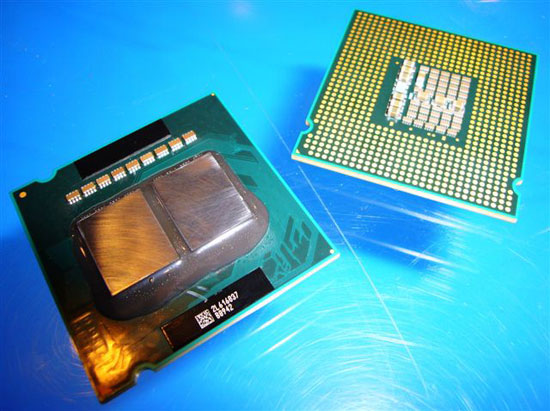
The problem with Intel's approach is that all traffic from one pair of cores to the next has to go over the FSB, whereas AMD's quad-core Barcelona design places all four cores behind a shared L3 cache. With a single socket quad-core chip, FSB bandwidth is already at a premium given that four cores have to share the same amount of FSB bandwidth that two cores do in a dual-core system. In theory, Intel's quad-core CPUs could stand to benefit more from a 1333MHz FSB than their dual-core counterparts. You may remember from our review of the Core 2 Duo E6750 that the 1333MHz FSB only accounted for an average performance improvement of 1.9% over the 1066MHz FSB, but would things change with four cores running on the other end of that FSB?
To find out we compared the Core 2 Extreme QX6850 to the Core 2 Extreme QX6800, the former running at 3.0GHz on a 1333MHz FSB and the latter 2.93GHz/1066MHz. There is a 2.3% increase in clock speed that the QX6850 enjoys over the QX6800, but we can easily take that into account when looking at the margin of victory in our tests.
The chart below shows the performance increase the QX6850 sees over the QX6800 across our entire suite of benchmarks:

The faster FSB appears to do a little more with the quad-core QX6850 than we saw on the dual core E6750. The performance advantage is not tremendous, amounting to little more than low single-digit percentage point advantages across the board. Taking into account the ~2.2% increase in clock speed that accompanies the QX6850, an average of around a 2% increase in performance is what we'd attribute to the faster FSB.
By no means is it earth shattering or necessary for that point, at least not at these clock speeds. However, given the direction Intel is going in, if you're building a new system today you'll obviously want to opt for a 1333MHz FSB processor. Current quad-core owners shouldn't feel pressure to upgrade, the faster FSB does very little for performance.
Affordable Quad Core: AMD Athlon 64 FX-74 vs. Intel Core 2 Quad Q6700
AMD doesn't have any quad-core CPUs on the market today, but you can get four cores in a single motherboard by going with a Quad FX platform. AMD's attempt at building a enthusiast class dual socket, dual core platform is far from the most elegant solution in the world, but it does provide an interesting upgrade path. The Quad FX platform uses Socket-1207 CPUs and will be able to be upgraded to dual quad-core chips when they are available, giving you eight cores on a desktop motherboard. Intel has a similar offering called V8, but the AMD Quad FX platform uses standard desktop DDR2 memory which makes it infinitely more attractive.
The problem with Quad FX is that the motherboard is expensive, the whole platform consumes a great deal of power, and you can just as easily get a single socket, quad-core solution from Intel for less money. We haven't revisited Quad FX vs. Quad-Core since AMD introduced the platform, and since then there have been some price cuts on both sides of the fence. AMD now sells two Socket-1207 Athlon 64 FX-74 processors (3.0GHz) at $599 for the pair, making it quite cost competitive with Intel's Core 2 Quad Q6700 ($530).
If we forget about the added cost of a Quad FX motherboard for the moment, how do the two similarly priced processors stack up? The chart below shows the performance advantage/disadvantage the Q6700 holds compared to the FX-74:

That's not very pretty for AMD. The Athlon 64 FX-74 ends up being 1.1% faster in Cinebench but on average, the Q6700 is 14.1% faster than the more expensive Quad FX platform. The only benefit you get with Quad FX is the ability to eventually upgrade it to eight cores, but in our opinion for the majority of users the upgrade path is simply not enough to justify the means to get there.
Taking advantage of four cores on the desktop is tough enough today, and if you really need 8 cores today buying a platform that will support it in the future isn't going to help make your applications faster now. The market for Quad FX continues to be limited and our original recommendation from the first Quad FX review stands: you're better off with Intel's quad-core.
$180 Battle: AMD Athlon 64 X2 6000+ vs. Intel Core 2 Duo E6750
It's time for round three; at around $180 you can either get AMD's fastest Socket-AM2 processor, the Athlon 64 X2 6000+ or Intel's Core 2 Duo E6750, it's second fastest, non-extreme, dual-core processor. After the April price cuts, AMD managed to become quite competitive with Intel below $300, have things changed now that Intel is readying its own set of price cuts for next week?

In the old pricing scheme, AMD's 6000+ had to compete with the 2.4GHz Core 2 Duo E6600 and 2.13GHz E6400, which it did well. Unfortunately for AMD, the Athlon 64 X2 6000+ now has to compete with the 2.66GHz/1333MHz FSB Core 2 Duo E6750 and the battle is far from balanced this time around.
Unless you already own a Socket-AM2 motherboard, the E6750 is the clear choice at $180.
$160 Battle: AMD Athlon 64 X2 5600+ vs. Intel Core 2 Duo E6550
In our last AMD vs. Intel battle of the day, we've got the Core 2 Duo E6550, a newcomer at 2.33GHz vs. the AMD Athlon 64 X2 5600+. The price point is around $160, and the stakes are high but once again, AMD is up against stiffer competition. The X2 5600+ used to be priced at the Core 2 Duo E6300 (1.86GHz) level, but now it's up against a 2.33GHz bohemoth by comparison.

The X2 5600+ manages to pull three wins, besting the E6550 under Cinebench, Lightwave and one of the Lost Planet tests, but it is still no match for its competition at this point. The 5600+ used to hang with the Core 2 Duo E6300, but its new competitor has a 25% higher clock and will have a price parity as of next week. Our recommendation stands.
The Million Dollar Question: Dual or Quad Core for the Same Price?
Before talk of Intel's July 22nd price cuts surfaced, we were hardly ever asked the question "dual or quad", simply because the price differential was so great. After next week everything changes, as you'll be able to pick up a quad-core Q6600 (2.4GHz) for a measly $266. At the same time, you could get a much higher clocked dual-core E6850 (3.0GHz) for the exact same price - so which do you pick?

This graph is a lot more colorful than our previous ones because the decision just isn't that clear. If you look at the average, quad-core gains an advantage over dual-core over all of our benchmarks, but if you look at the tests themselves you'll see some trends. Encoding and 3D manipulation benchmarks have the quad-core CPU clearly ahead, while general usage and gaming benchmarks mostly favor the higher clocked dual-core E6850. So, which do you choose?
If you're strictly building a gaming box, you'll get more performance out of the dual-core E6850. However, if you do any encoding or 3D rendering at all, the quad-core Q6600 is a better buy. Our pick is the Q6600 and if you want to make up the performance difference you can always overclock to E6850 speeds, but the chip only makes sense if you're running apps that can take advantage of four cores. As the chart above illustrates, those applications are almost exclusively limited to video encoding and 3D rendering.
Extremely, Mobile?
As a brief sidenote, Intel is announcing its first mobile Extreme Edition processor today - the Core 2 Extreme Mobile Processor X7800. The X7800 is based on Intel's Merom core (mobile version of the desktop Core 2 Duo), and runs at 2.60GHz on an 800MHz FSB. The chip features the same 4MB shared L2 cache as other high end mobile Core 2 processors, and like all desktop Extreme Edition CPUs, the X7800 is unlocked for more flexible overclocking.
Intel has been championing this trend of everything becoming more mobile for years now and is hoping to capitalize on users who want to configure high end gaming notebooks.
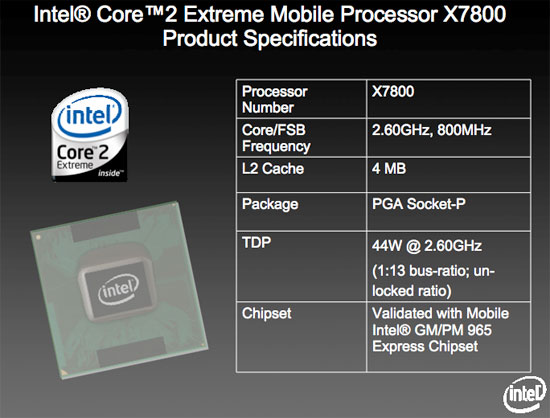
The first notebooks with the mobile Core 2 Extreme will start shipping in about two weeks. ASUS and HP will be among the first OEMs with systems available. You can expect the "Extreme" badge to carry a hefty pricetag as it does on the desktop, have fun lugging that burden around from one LAN party to the next.
The Rest of the Tests
We've answered the questions we set out to, but if you're looking for our usual lineup of graphs and numbers the following pages have just what the doctor ordered.
General Performance - SYSMark 2007

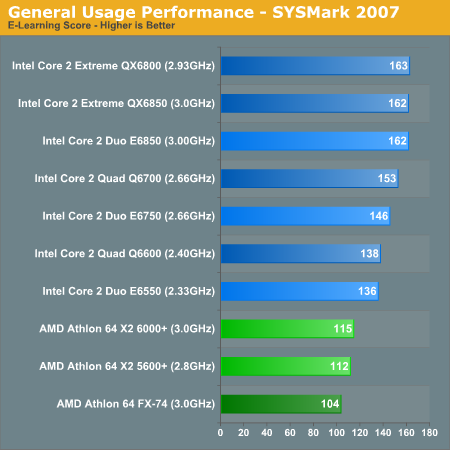
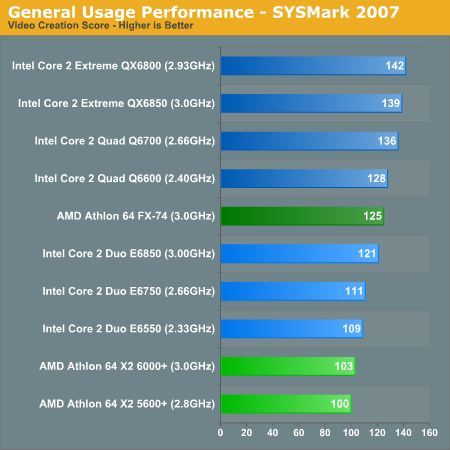
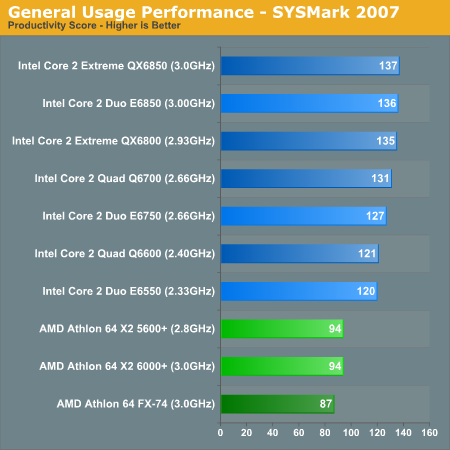
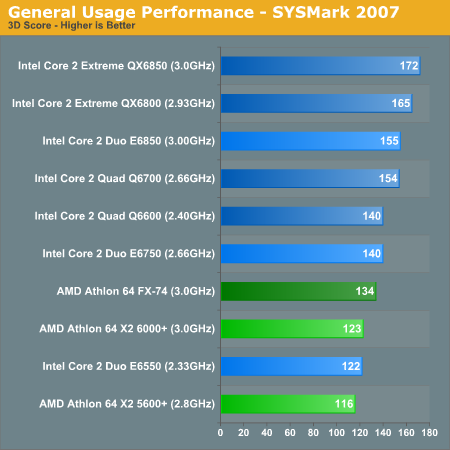
General Performance - PC WorldBench 6
PC WorldBench 6 focuses mostly on single application performance, with only a single multitasking benchmark in the entire suite.
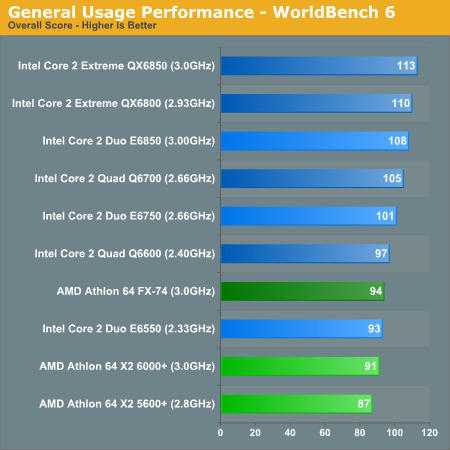
Media Encoding Performance
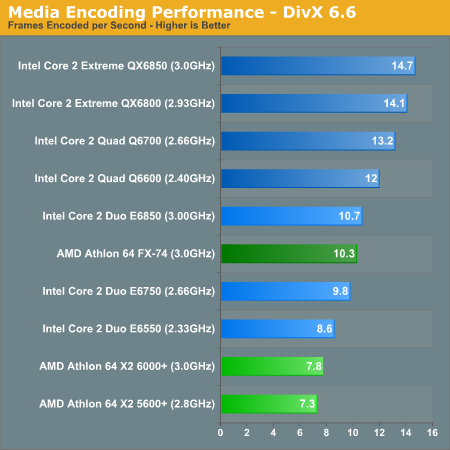
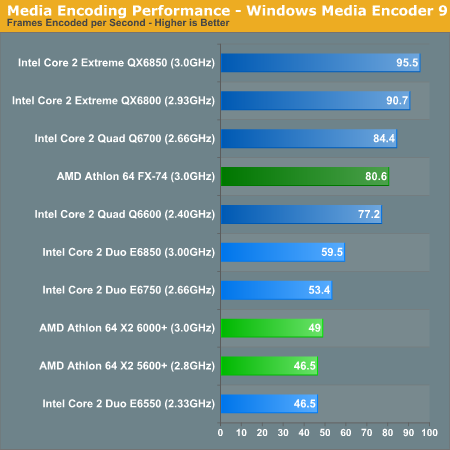
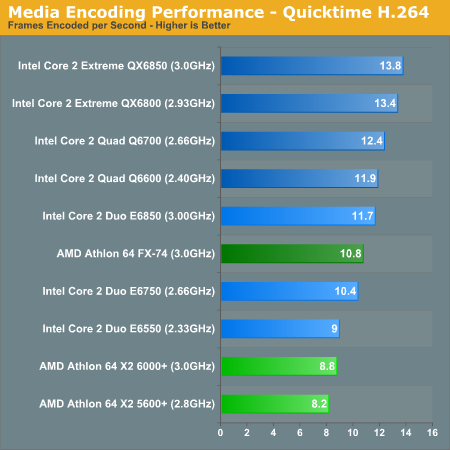
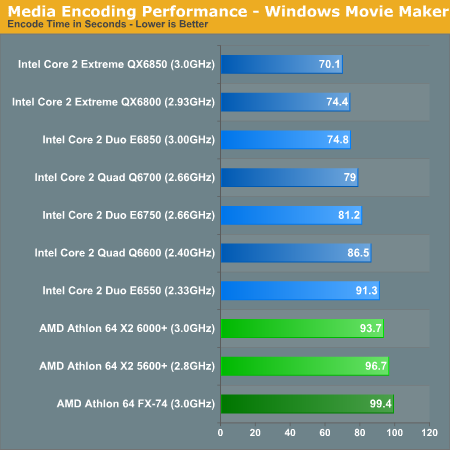
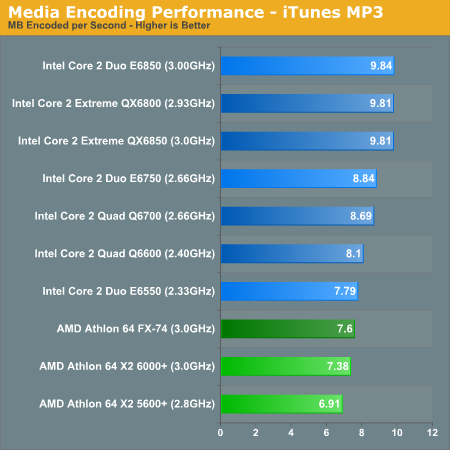
3D Rendering Performance
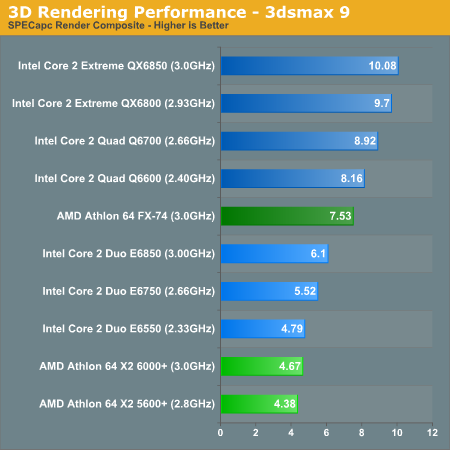
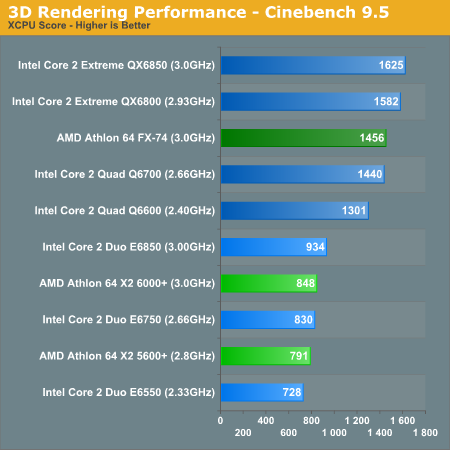
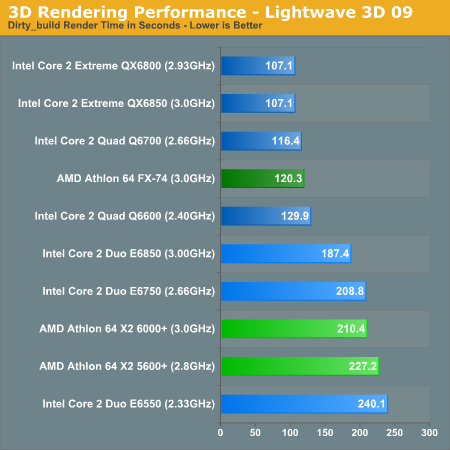

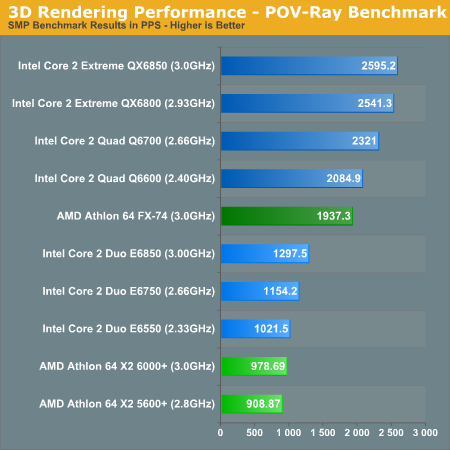
Photo Processing Performance
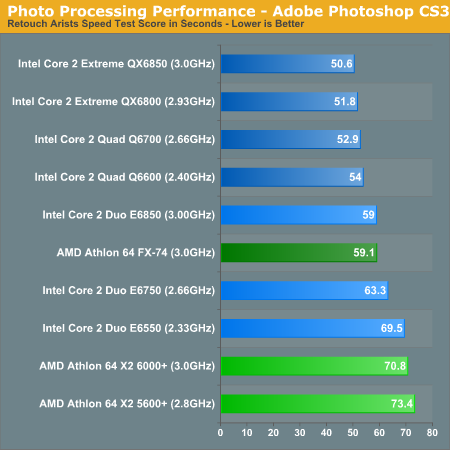
Gaming Performance
Our first 3D game test is our walkthrough of Bruma in the popular RPG Oblivion. This test was run at 1600 x 1200 with Very High quality defaults selected from Oblivion's launcher. FRAPS was used in this benchmark:
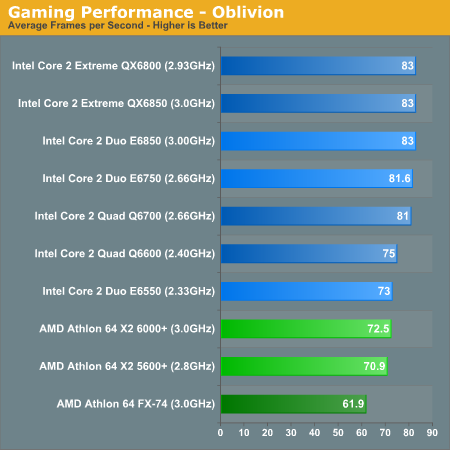
We ran Half Life 2: Episode One at 1600 x 1200, with all settings at their maximum values with the exception of AA/anisotropic filtering, which we left disabled.
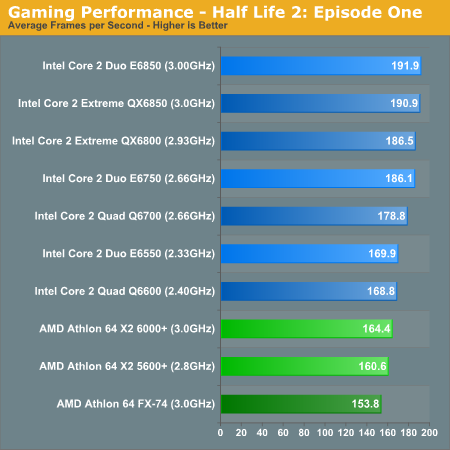
We ran Prey at 1600 x 1200 with High Quality textures, all detail settings were set to their highest options, no AA, and 8X aniso:

S.T.A.L.K.E.R. was tested at 1024 x 768 with full dynamic lighting enabled and high quality detail settings:
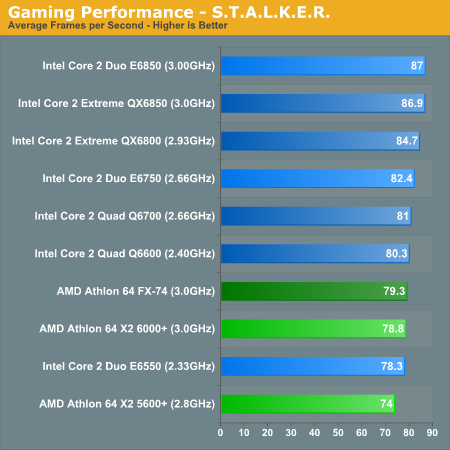
We ran Supreme Commander at 1024 x 768 with medium quality presets. We've changed our Supreme Commander benchmark a bit at the advice of Gas Powered Games' senior engineers. We created a skirmish with 7 AI players and let them duke it out for almost 30 minutes, we saved the replay and then measured the amount of time it took to playback the recording at maximum gamespeed (+10). The figures below are expressed in minutes, lower playback time being better:
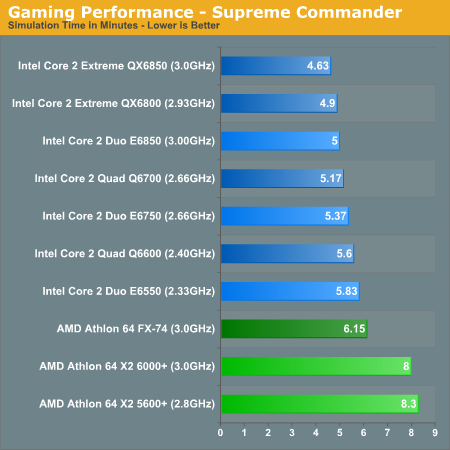
Capcom's Lost Planet demo is available in both DX9 and DX10 flavors, but for this review we used the DX9 version given that we've not been able to find any real benefit to running the DX10 version. We had to run Lost Planet at 800 x 600 with a mixture of high/medium quality settings:

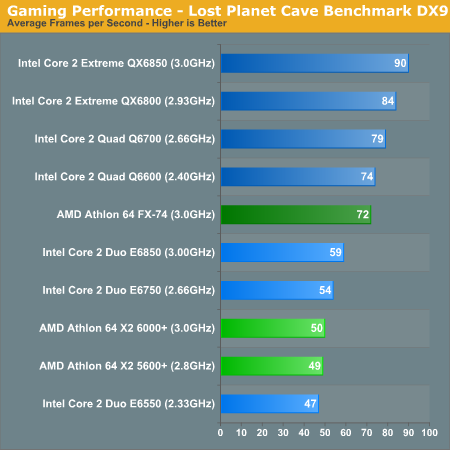
Final Words
Despite theoretical showings on paper, the 1333MHz FSB appears to do very little for performance even when feeding four of Intel's fastest cores. The Core 2 Extreme QX6850's performance is nothing to scoff at, but given its price tag we'd strongly recommend one of the cheaper quad-core offerings. With the Q6600 coming in at $266, it's tough to resist.
Our Q6600 recommendation really highlights the major focus of this story, and that is the escalating price war between AMD and Intel. Once Intel's price cuts take effect next week, it's going to be difficult to recommend any AMD CPUs above $150. We're still working on our low end CPU comparison, and we suspect that AMD is more competitive at the lower end of the price spectrum, but what we've seen here today doesn't look good at all for the mainstream segment. In order to remain competitive, AMD would either have to knock about $50 off its X2 6000+ price or count on Phenom making up the performance gap at the same price point.
It's tough to resist upgrading or building a new system today because of the tremendous value this last round of price cuts has given us, especially when you take into account that both Penryn and Phenom's respective launches remain largely unknown. Clock speeds, pricing and dates are still up in the air, and for once our recommendation isn't simply to wait and see what happens.
If you need a new system or CPU upgrade today, the chips are ripe for the picking.







